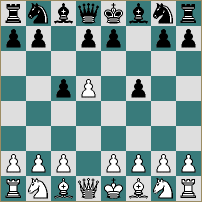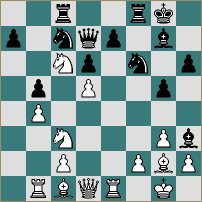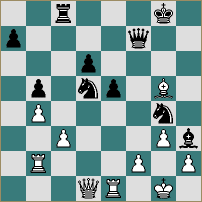Exploring A New Opening
In recent months I have been experimenting with an unusual opening, namely 1 d4 c5 2 d5 f5 - which has been dubbed the Clarendon Court Defence. Although one can find the odd game with it from yesteryear, and there is a very brief reference in E.C.O. (line A43), the move 2...f5 seems to have almost entirely escaped theoretical attention. In a footnote E.C.O. gives 2...f5 3 Nc3 Nf6 4 Bg5 Qb6 5 Rb1 d6 6 Nh3 Na6 7 Nf4 Nc7 8 e3 Ng4 9 h4 Bd7 10 h5, with a clear white advantage, Furman - Kirilov, SSSR 1971. However, 5...h6 (as I played against Lev Alburt at the New York Open, 1994) is an interesting improvement and brings the opening back to life. Indeed, my game with Alburt made it into Informator 60 (game 57) and, consequently, Tukmakov used 2...f5 to defeat Lputian at Tilburg (Informator 61/58).
There is still to my knowledge no significant printed theory on this system, although I recently scripted and presented a video using the Clarendon Court as the basis for a repertoire as Black against 1 d4 (about a quarter of the material deals with white alternatives to 2 d5, the rest is on the Clarendon Court). Grandmaster Video can be contacted at:
PO Box 50, Woking, Surrey GU22 7YT, England.
Arkell,K - Levitt,J
Clarendon Court Defence (A43)
4NCL, Slough, 1995
1 d4 c5
Against 1...c5, I believe 2 d5 is the only real threat, theoretically speaking. After 2 e4 Black takes on d4 and can either play a Sicilian or choose a less explored path: 2 e4 cxd4 3 Nf3 e5!? 4 c3 (and not 4 Nxe5?? Qa5+) Nc6! 5 cxd4 exd4 6 Nxd4 Nf6 7 Nc3 Bb4 with active piece play to compensate for the (temporarily) weak d-pawn.
2 d5 f5
 The defining move of the Clarendon Court. White has a number of different approaches to this position - in the video I split them into three:
A) attempts to smash the opening flat; e.g. 3 e4, 3 h4 and 3 Nc3 Nf6 4 f3
The defining move of the Clarendon Court. White has a number of different approaches to this position - in the video I split them into three:
A) attempts to smash the opening flat; e.g. 3 e4, 3 h4 and 3 Nc3 Nf6 4 f3
B) the sharp ‘main line’: 3 Nc3 Nf6 4 Bg5 Qb6, as in Alburt -Levitt and
C) positional lines with g3 (with or without c4). In these lines play can resemble the Leningrad Dutch - Black often gets a weakness on the e6 square, but has active and aggressive piece deployment to compensate. In my experience so far, the positional approach has been the most common (but usually only after a twenty minute think). Grandmaster elect Keith Arkell went for it too.
3 Nc3 Nf6
4 g3 d6
5 Bg2 g6
6 e4 Bg7
Black does not need to take on e4 until White threatens to play e5. The opening has resulted in a structurally typical situation - a weakness on e6 vs active play for Black.
7 exf5 Bxf5
8 Nge2 Na6
Menacing Nb4, but happy to go the other way once White prevents it. From c7 the knight supports ...b5 and covers the sensitive e6 point. It is often a major choice for Black whether to play Nb8 - a6 - c7 or Nb8 - d7 - e5.
9 a3 Nc7
10 0-0 b5
Risky, since White gets a chance to get a knight to the weakened c6 square. Castling would be perfectly acceptable for Black, who can count the opening a reasonable success..
11 b4 0-0
12 Rb1
Not interested in trying to win material with 12 bxc5 dxc5 13 d6 exd6 14 Bxa8 Qxa8 15 Qxd6 Bh3. Wise!
12 ... cxb4
13 axb4 Qd7
14 Nf4 Rac8
Both sides have serious weak points: c2, c3, c4 and d5 are all a little vulnerable for White, while e7, e6 and c6 are Black’s soft spots. When you already have a lot of weaknesses it can sometimes be a good idea to create some more, since your opponent can only exploit so many! Needless to say, you should be sure to get some activity before following this unconventional advice.
15 Re1 g5
16 Nfe2 h6
Tactics backfire: 16...Ncxd5? 17 Nxd5 Bxc2 18 Nxf6+ Bxf6 19 Qd5+ e6 20 Qa2!
17 Nd4 Bh3
18 Nc6
 As my opponent put it after the game: ‘White's got his dream position and it's completely lost!’. At first it loks as if e7 is just dropping off, but White’s position is too loose.
As my opponent put it after the game: ‘White's got his dream position and it's completely lost!’. At first it loks as if e7 is just dropping off, but White’s position is too loose.
18 ... Rce8
19 Bh1
The point is that 19 Nxe7+ Kf7! 20 Nc6 Bxg2 21 Kxg2 allows 21...Ncxd5 22 Nxd5 Qxc6! with a fatal pin. White tries to go passive, but the d5-pawn is about to drop.
19 ... Ng4
Threatening both f2 and c3.
20 Ne4 Rf5!
21 Nd4 Rxd5
22 c3 e5
23 Nxg5 hxg5
Black is now winning, but Arkell plays resourcefully to set me problems.
24 Bxd5+ Nxd5
25 Nf3 Qf7
Simpler would be 25...Ngf6, but I wanted to exploit the attacking position around the white king..
26 Rb2! Bh6
26...Nxc3 is met by 27 Qb3! when the bishop on h3 proves to be a liability.
27 Nxg5 Bxg5
28 Bxg5
28 ... Rc8?
 Natural but wrong. The winning path was: 28...Rf8! 29 f3 Qxf3 30 Qxf3 Rxf3 31 Rd2 Nxc3 32 Rxd6 Ne2. In time trouble I thought I saw a brilliant tactic...
Natural but wrong. The winning path was: 28...Rf8! 29 f3 Qxf3 30 Qxf3 Rxf3 31 Rd2 Nxc3 32 Rxd6 Ne2. In time trouble I thought I saw a brilliant tactic...
29 f3 Nxc3
I had missed that after 29...Nxc3 30 Qb3 Qxb3 (30...Rc4!?) 31 Rxb3 Ne2+?? 32 Rxe2 Rc1+, White has 33 Bxc1. In mutual panic I offered a draw. We both missed that White is probably better after 30 Qxd6, but just about anything might have happened in the time scramble. 30...Qxf3? allows 31 Qe6+ and 32 Qxc8 since Black is not threatening mate. Black would have to find 30...Rf8 when if White could avoid 31 fxg4?? Qf1+, he might have had good chances after 31 Bh6!
Draw agreed.
Displaying a slight lack of small, spherical objects, but it had been a hard weekend.
Back
Top of this page
Main page


